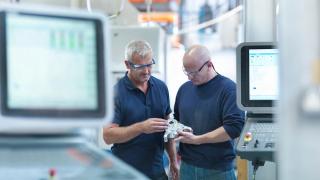Glen Rabie, the CEO of Australian technology start-up Yellowfin, wrote an op-ed in the Australian Financial Review a couple weeks ago that caught my attention. Decrying the ‘disconnect’ between the Australian Government’s rhetoric around promoting innovation and its own purchasing habits, Rabie argued that ‘for all the focus on local innovation, nearly all of this technology spending will go to international consulting firms and vendors.’ In terms of encouraging start-up participation in government contracts, Rabie doesn’t mince words: ‘If our federal government set out with the sole aim of designing a tender system that discouraged start-up participation, they could not do much better than the current regime.’
In the defence space, where the rallying cry of this government and, in particular, the Minister for Defence Industry, Christopher Pyne, has been linking our growing defence spending to technological innovation and economic growth, looking for ways to include Australian tech start-ups in the defence sector at an early stage is crucial. Efforts to streamline the defence tender process for small business, like the Defence Innovation Portal, and provide capital primarily through the Next Generation Technologies Fund are good starts in this direction. I don’t think anyone would disagree that simplifying the tender process for government national security needs or having the government invest in niche or strategic technology areas are good ideas.
But what about a body that does both at the same time?
Rabie brings up an interesting example from the United States. He suggests that the government set up a venture capital firm akin to the CIA’s In-Q-Tel that would focus on investing in early-stage Australian technology companies and assisting them in gaining government contracts—which is a crucial stepping stone in the life cycle of many start-ups. While Rabie wasn’t necessarily pitching the idea in the defence industry space, it might be something Australia should consider for our defence industry.
In-Q-Tel was set up by a former president of Lockheed Martin, Norman Augustine, in 1999 with the aim of leveraging existing commercial technologies in the market for the strategic goals of the intelligence community (IC). It has since grown to be funded by several different agencies, and the focus of its technology investments has multiplied. Current areas of interest are everything from power and energy technology to digital infrastructure, data analytics and biotech.
Critically, the firm is run entirely independently of the CIA. It’s staffed by people with backgrounds in the private sector and has a goal to have a high turnover in employees, similarly to DARPA. The CIA has a dedicated ‘interface centre’ with In-Q-Tel that canvasses the IC for technological needs and goals, declassifies the information and then feeds it to the firm, informing investment priorities.
A bonus is that the firm is relatively self-sustaining. Profits are reinvested into In-Q-Tel’s own ‘operations, technologies and programs’, meaning in practice that its goals are for the strategic benefit of the IC rather than financial profit. Crucially, In-Q-Tel ‘does not seek government-specific solutions, but instead focuses on identifying commercial analogs … where the needs of the market and the IC meet.’
Unsurprisingly, In-Q-Tel operates in a fairly unique way compared to other venture capital firms. Rather than focusing on business models, In-Q-Tel focuses on the underlying technology and the strategic value of the start-up to the IC, relying on its own in-house technical experts to work with companies to bring their products to government tender standard. This also allows the firms to have value-added services that come with its investment; it can afford to spend the time and effort with firms that it has invested in, in order to guide them through technological and funding hurdles as well as the government tender process.
Another benefit of the track record and reputation of the firm is that its investments also attract other private sector capital. Because of its high standards, technical assessments and government backing, it’s been estimated that for every dollar In-Q-Tel invests other venture capital firms invest eight. For some technologies, this would have the added benefit of bringing solutions to government that would otherwise be unaffordable. One of the biggest success stories of early In-Q-Tel backing is the national security data company Palantir, which has now expanded beyond the IC and into finance, medical research and insurance.
Something like In-Q-Tel might suit Australia’s needs. One of the persistent problems of Australia’s start-up and technology innovation sector is a lack of capital. Australia’s venture capital community has been consistently singled out as ‘risk averse‘ and surveys have highlighted raising investment funds as one of the industry’s biggest challenges. The Next Generation Technologies Fund is making investments in niche strategic areas, but most of its funding is concentrated in mid- and large-scale projects, such as quantum computing research in major universities and hypersonic technology driven by Boeing and Lockheed. For FY 2016–17, only $2.8 million has been put aside for small-scale investment, of which $600,000 is dedicated to establishing a pilot program geared towards small business innovation.
Governments will naturally always have to make investments in basic research that can’t be conducted by small, innovative technology companies, such as university-driven quantum computing labs. But In-Q-Tel could provide an interesting example in the Australian context of helping to find solutions and companies that already exist in the market and bringing them to government tender by injecting both capital and expertise. The Defence Innovation Portal and the Next Generation Technologies Fund are both necessary steps in reforming Australia’s defence industry policy and driving innovation in technologies critical to Australia’s national security. But a venture capital firm that is informed by, but separate from, government would remain nimble enough to keep up with the rapid pace of the technology and innovation sector while being a vehicle for capital and expertise.






